Introduction
The Dangerous Substances and Explosive Atmospheres Regulations 2002 (DSEAR) came into force on 9th December 2002 and applies to workplaces in the majority of industrial and commercial sectors.
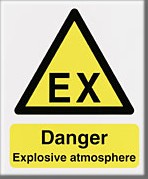
DSEAR provides for the protection against risks from fire, explosion and similar events arising from dangerous substances used or present in the workplace, and sets minimum requirements for the protection of workers from fire and explosion risks related to dangerous substances and potentially explosive atmospheres.
DSEAR is concerned with the harmful physical effects from thermal radiation (burns), over-pressure effects (blast injuries) and oxygen depletion effects (asphyxiation) arising from fire or explosions
The various areas within a DSEAR Site must be appropriately identified and signage must be in use where personnel have access to hazardous areas.
Typically, where pedestrian acces is needed then an example sign might be as shown here.
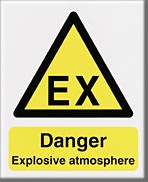
The key requirements are that risks from dangerous substances are
Assessed then eliminated or reduced;
That procedures and equipment are available to deal with accidents and emergencies;
That employees are provided with the appropriate information and training;
That places where explosive atmospheres are likely to occur are classified into hazardous zones and suitably protected and marked.
The Regulations revoke, repeal or modify a significant amount of old legislation which relates to flammable substances and dusts, and will be maintained through the DSEAR requirements and HSE
Approved Codes of Practice (ACOP’s). .
DSEAR complements the general requirement to manage risks under the Management of Health and Safety at Work Regulations 1999 and addresses risk to person’s safety from dangerous substances, as opposed to risk to health which is addressed by the Control of Substances Hazardous to Health (COSHH). HSE have produced several codes of practice for industry, see section og DSEAR Guidance for details
Scope of DSEAR
DSEAR applies to the following:
a) Work being carried out by an employer or self-employed person;
b) A dangerous substance is present, or is liable to be present at the workplace;
c) The dangerous substance presents a risk to the safety of persons (as opposed to health).
‘Workplace’ means any premises, or part of premises used for work, this includes all industrial, commercial premises.
DSEAR is intended to protect not only employees at the workplace, but also any other person whether or not at work who may be put at risk by dangerous substances. This includes employees, contractors, visitors to the site, etc.
Responsibility for Implementation
The employer has the responsibilities for complying with DSEAR; and should ensure that suitable and sufficient risk assessments are undertaken and that the measures identified by the risk assessment are implemented.
Activities/substances to which DSEAR apply
The following identifies the type of substances used in industry and commence that comes under the scope of DSEAR:
Storage of highly flammable liquids, including petroleum spirit
Use of flammable gases, such as acetylene, for cutting and welding
Handling and storage of waste dusts from woodworking operations
Handling and storage of flammable wastes including fuel oils
Hot work on tanks or drums that have contained flammable material
Work activities that could release naturally occurring methane
Use of flammable solvents in laboratories
Storage of flammable goods, such as paints, solvents, reagents
Storage, use and handling of flammable gases, including LPG
Transport of flammable liquids in containers around the workplace
Chemical/gas manufacture, resulting from process or research experiment
This list is not comprehensive.
Determining the presence of dangerous substances
Dangerous substances are defined as substances or preparations that are classified as explosive, oxidising, extremely flammable, highly flammable or flammable in terms of the Chemicals (Hazard Information and Packaging for Supply) Regulations 2002 (CHIP).
Step1. Check whether the substances have been classified under the Chemicals (Hazard Information and Packaging for Supply) Regulations 2002 (CHIP) as explosive, oxidising, extremely flammable, highly flammable or flammable. Where dangerous/hazardous substances are supplied for use at work, suppliers must provide safety data sheets which should identify whether the chemical is classified under the CHIP Regulations as flammable, oxidising, etc.
An additional source of information is the HSE’s Approved Supply List, which contains commonly used substances together with their classifications.
For the purposes of CHIP:
i. Flammable Liquid is one with a flash point of >21°<55°C,
ii. Highly Flammable Liquid is one with a flash point of <21°C
iii. Extremely Flammable Liquid is one with a flash point <0°C and a boiling point of <35°C.
Substances recognised under CHIP are identified by the symbols:

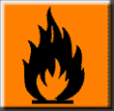
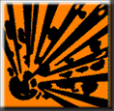
Step 2. Assess the physical and chemical properties of the substance or preparation and the circumstances of the work involving those substances to see if they can create a safety risk to persons from a fire, explosion or similar energetic event. If so, a dangerous substance is present.
Wood and many other dusts may be dangerous substances, depending on the circumstances of the work.
Dusts mixed in a cloud with air can, in certain circumstances, be ignited and explode.
If the assessment shows that there is a safety risk to persons arising from fire, explosion or other energy-releasing event then the substance is a dangerous substance for DSEAR purposes.
Risk Assessment (Regulation 5)
Where dangerous substances are identified as being present in the workplace, DSEAR requires that employers (or the self-employed) undertake suitable and sufficient assessment of the risks to employees arising from those substances.
The purpose of the assessment is to enable employers to determine what measures are necessary in order to eliminate or reduce the risk to reasonably tolerable and/or controllable levels, and the general methodology embodied in other legislation for conducting risk assessments are replicated in DSEAR.
The risk assessment should include amongst other considerations:
The hazardous properties of the substance
Safety information provided
Circumstances of the work
Activities such as maintenance, which heightens the risk
Effects of measures taken
Likelihood and persistence of explosive mixtures
Presence of ignition sources
The risk assessment should be reviewed periodically and whenever (process) changes have occurred.
Where 5 persons or more are employed, the employer is required to record the significant of the risk assessment. This record should include:
The measures identified by the assessment
Information on the safety arrangements for the workplace
Processes and work equipment
Information where an explosive atmosphere may occur
Places are appropriately classified into zones,
Appropriately certified equipment is only used in the zones.
Where dangerous substances are introduced into the workplace a risk assessment should be completed before the substance is used.
Elimination or reduction of risks from dangerous substances (Regulation 6)
Employers are responsible under DSEAR for eliminating or reducing the risk from dangerous substances where reasonably practicable. This would be the substitution of a dangerous substance with a less hazardous alternative or by replacing a process with one presenting less risk.
Where eliminating or significantly reducing a risk is not practical, the employer should establish measures consistent with the risk assessment that control risks and reduce the detrimental effects of fire or explosion or any other physical harm arising from dangerous substances.
Measures for controlling the risk could include reducing the quantity or minimising or avoiding the release of a dangerous substance, preventing the formation of a flammable atmosphere, establishing arrangements for dealing with any release of dangerous substances, avoiding ignition sources and adverse conditions and segregating incompatible substances.
Measures for the reduction of the harmful effects of fire or explosion could include avoiding the propagation of fire or explosions, providing facilities for explosion pressure relief, suppression or containment, providing personal protective equipment or minimising the numbers of employees exposed.
Suitable arrangements should be established for the safe handling; storage and transport of dangerous substances, including waste containing dangerous substances, and any arrangements established for the elimination or reduction of risk are maintained.
Measures taken to achieve the elimination or the reduction of risk should include:
The design, construction and maintenance of the workplace (e.g. fire-resistance, explosion relief);
The design, assembly, construction, installation, provision, use and maintenance of suitable work processes, including all relevant plant, equipment and protection systems; and the application of systems of work including, written instructions, permits to work and other procedural systems of organising work
Places where explosive atmospheres may occur (Regulation 7 & Schedule 2)
Areas where explosive atmospheres may occur require to be classified into hazardous and non-hazardous places and any hazardous workplace should also be classified into zones.
Hazardous area classification should be undertaken as part of the risk assessment process and the information recorded. The purpose is to ascertain the extent to which an explosive atmosphere occurs which will determine the level of protection required to prevent sources of ignition.
Hazardous places are classified in terms of zones on the basis of the frequency and duration of the occurrence of an explosive atmosphere.
The zones for gas are:
Zone 0 through zone 1 to zone 2, zone 0 being the worst case whilst zone 2 being the least onerous. The zones for the dust environments are similar to gases these being identified by zone 20, zone 21 and zone 22.
Equipment and protective systems for all places in which explosive atmospheres may occur must be selected in accordance with the requirements contained in the Equipment and Protective Systems Intended for Use in Potentially Explosive Atmospheres Regulations, 1996.
The employer is responsible for ensuring that the standard of equipment and protective systems provided are appropriate to the hazard classification of the zone. The access point to places so classified should be marked with the appropriate sign.
Signage must be triangular in shape and have black letters on yellow background with black edging and the yellow portion must take up at least 50% of the area of the sign
All workplaces in use after 1 July 2006, and where applicable, MUST comply with DSEAR.
Prior to the first time use of a classified area, the employer is responsible for ensuring that the area’s explosion safety has been verified by a competent person.
The employer is also responsible for ensuring that persons operating in hazardous classified areas are provided with clothing that does not produce an electrostatic discharge.
Arrangements to deal with accidents, incidents and emergencies (Regulation 8)
Employers are required to assess the likelihood, scale or magnitude of the effects of any foreseeable accident, incident, emergency or any other occurrence involving a dangerous in the workplace. Resulting from this assessment, employers should establish suitable emergency arrangements to both safeguard people on the premises and minimise the impact of such an occurrence. Procedures should include:
Provision of first aid facilities and safety drills
Details of relevant work hazards and hazard identification
Specific hazards likely to arise at the time of an incident
Suitable warning (including visual and audible alarms) and communications systems
Escape facilities appropriate to that required by risk assessment
Contacting the emergency services to advise them that information on emergency procedures is available (and providing them with any information they consider necessary)
Making information on the emergency procedures available to employees
Specialised equipment and clothing for essential personnel dealing with the incident
Information, instruction and training (Regulation 9)
Where a dangerous substance is present employers are required to provide employees, and other people at the workplace who might be at risk, with suitable information, instruction and training on precautions and actions they need to take to safeguard themselves and others, including:
Names of the substances in use and risks they present
Access to any relevant safety data sheet
Details of legislation that applies to the hazardous properties of those substances
The significant findings of the risk assessment
Employers should also make this information available to employees’ representatives.
Information, instruction and training need only be provided to non-employees where it is required to ensure their safety. Where it is provided, it should be in proportion to the level and type of risk.
Identification of hazardous contents of containers and pipelines (Regulation 10)
Where containers and pipes used in the workplace contain a dangerous substance and are not marked (identified) under existing regulations, the employer shall ensure that the containers and pipes are clearly identifiable.
The marking or identification of the dangerous substance alerts employees and others who are in the workplace to the presence of a dangerous substance. This will ensure that adequate precautions can be taken to ensure the safety of the person on the site.
Identification also ensures incorrect mixing of dangerous substances.
Duty of co-ordination (Regulation 11)
Where two or more employers share the same workplace and where an explosive atmosphere may occur, the employer for the workplace shall ensure compliance to DSEAR by the use of the measures identified within this guidance.
Find out more at www.dsear.org.uk or contact info@dsear.org.uk
One must not forget the obvious signs, where these are needed
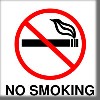
All equipment certified under the ATEX Directive 94/9/EC, must be appropriately marked, and the main identification symbol which must be placed on the equipment is shown opposite.
This must be followed by the appropriate code for the type on environment where the equipment can be used.
Such as
II 2 G/D
The first letters (II) represent the group of the Equipment. in this example for above ground use.
The second numeral (2) relates to the Category of equipment, either 1, 2 or 3 depending on the severity of the environment.
Equipment Categories
The ATEX Directive, in Annex I, defines five categories of equipment:
M1 and M2 (mining use)
CAT 1, CAT 2, and CAT 3 (non-mining use)
Finally, the remaining letters indicate either (G) a Gaseous environment or (D) a Dust environment or as in our case both
Visit our other web resources SDA Compliance | CE Mark Consultancy | SDA Technical Services | DSEAR & ATEX Consultants | One Directory